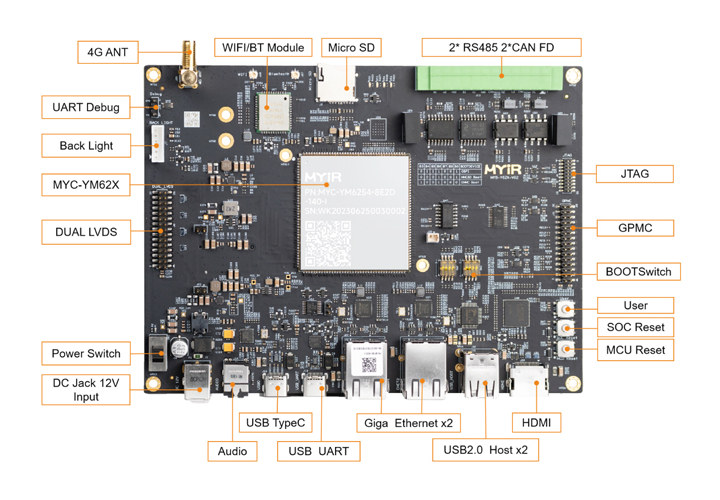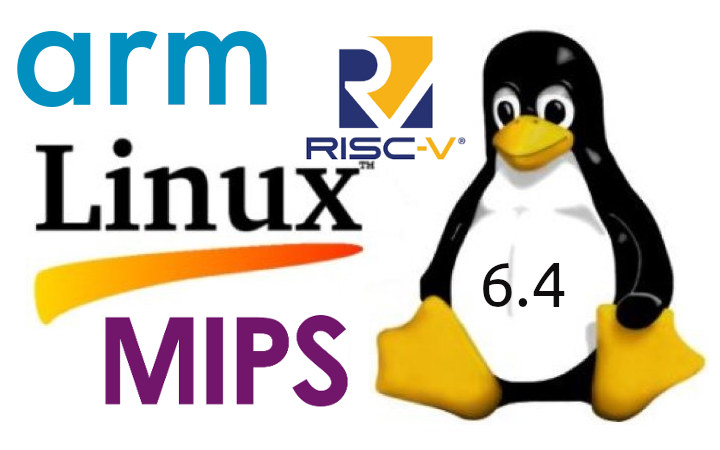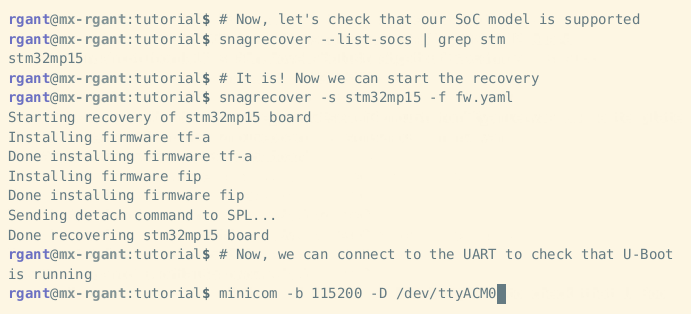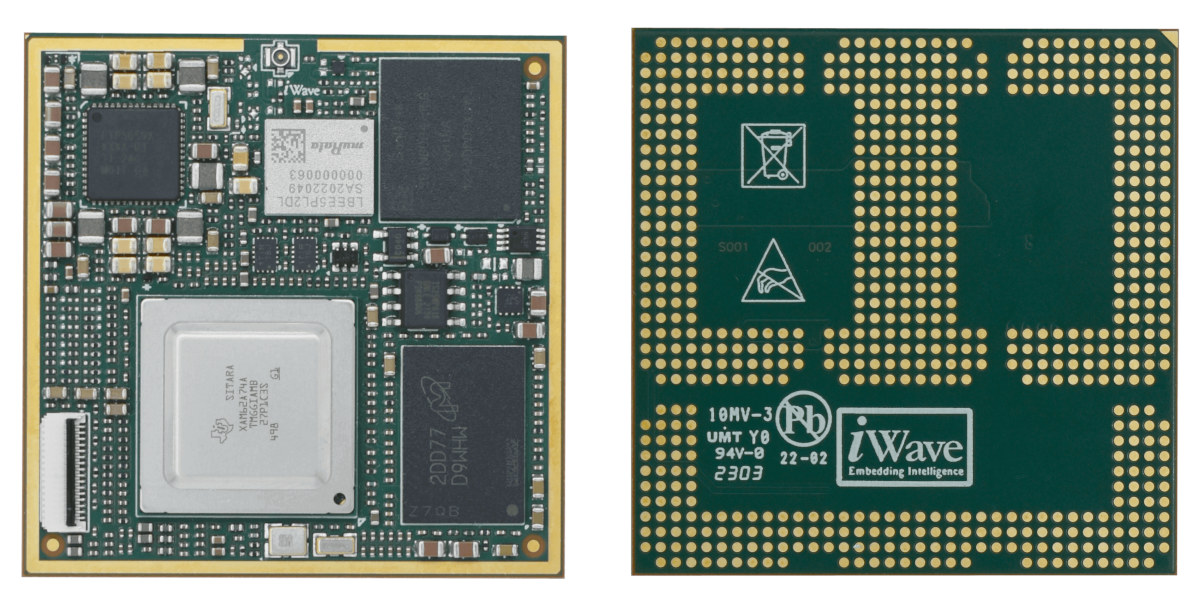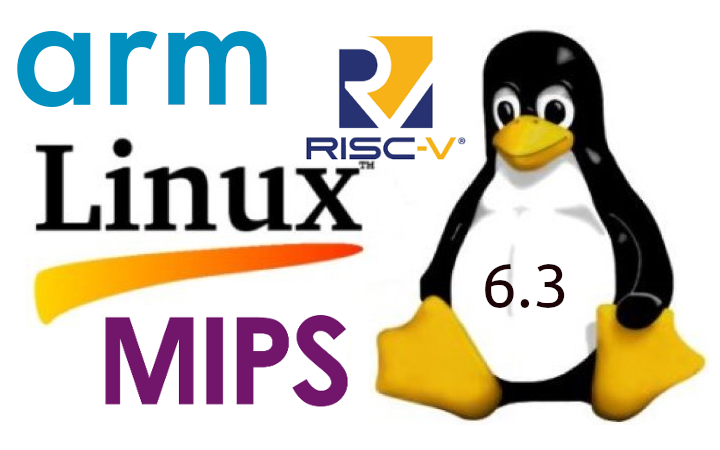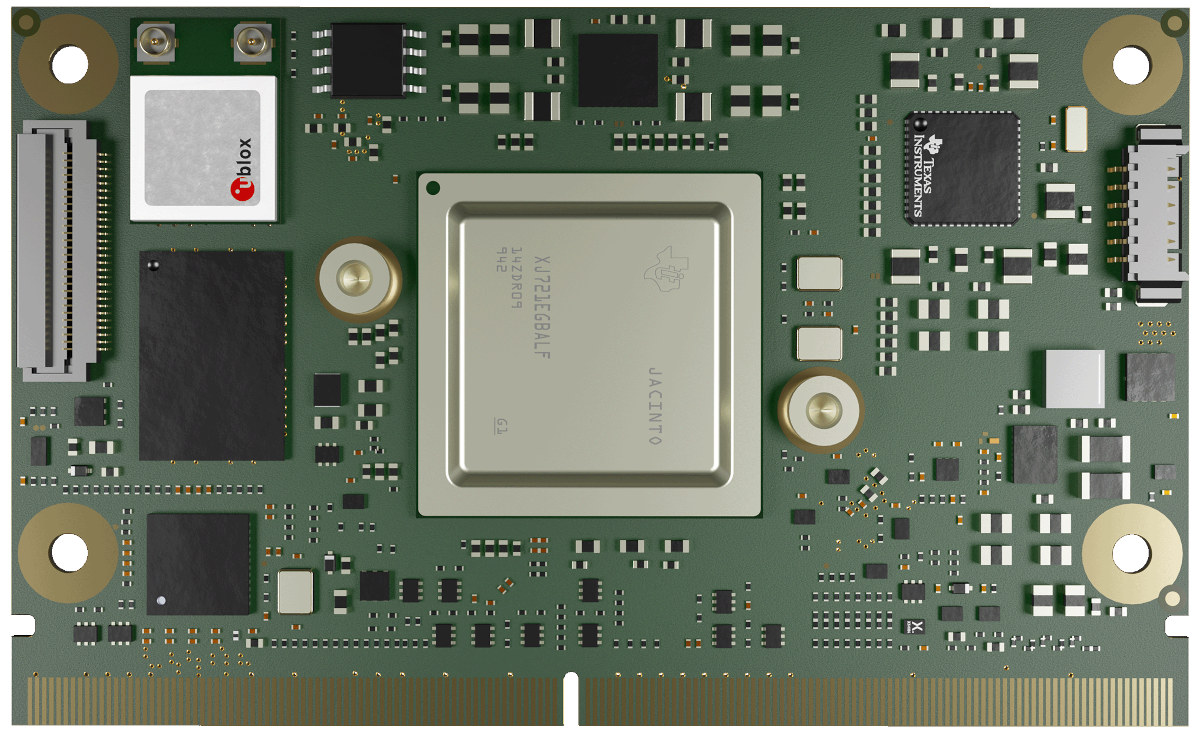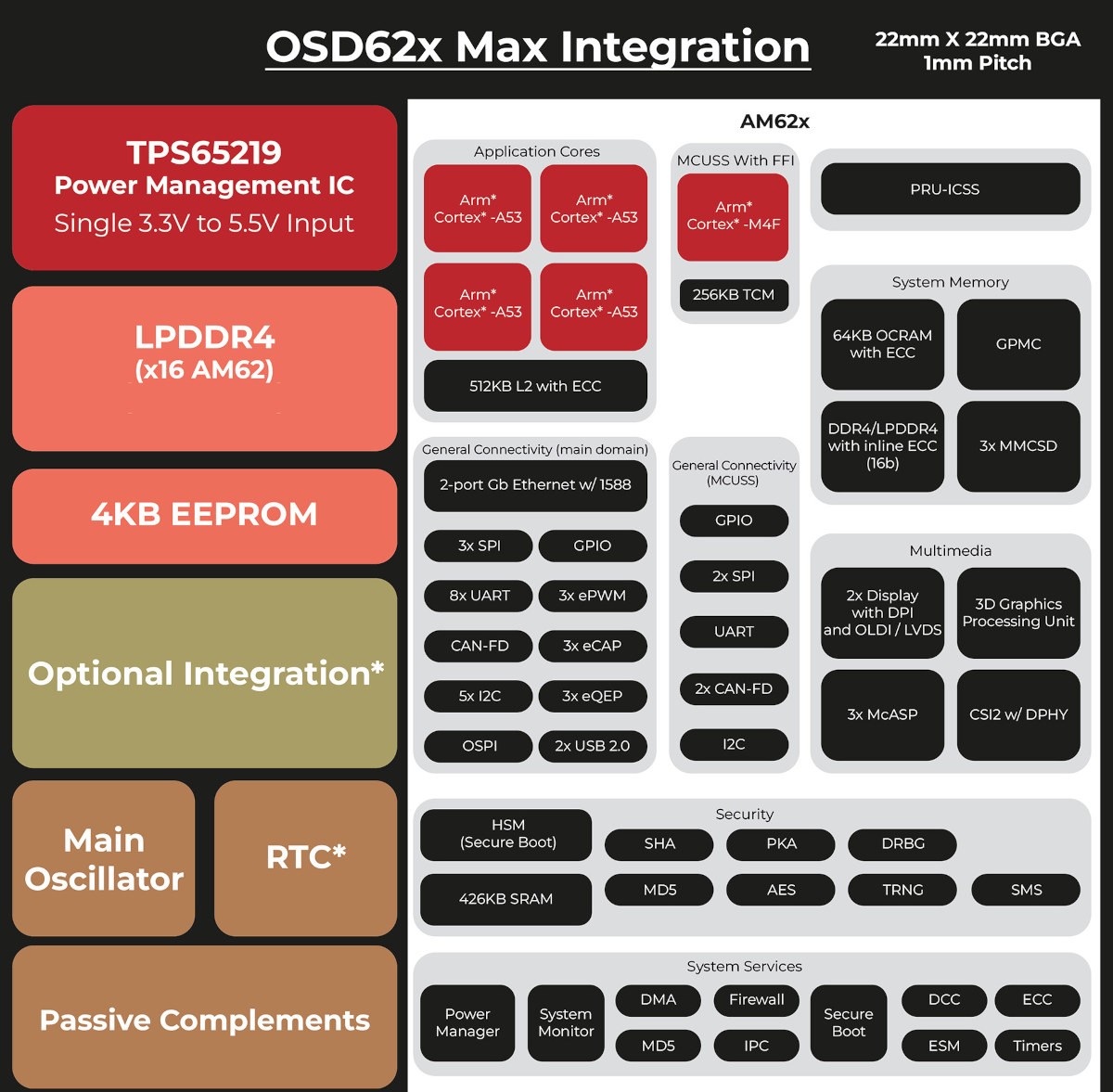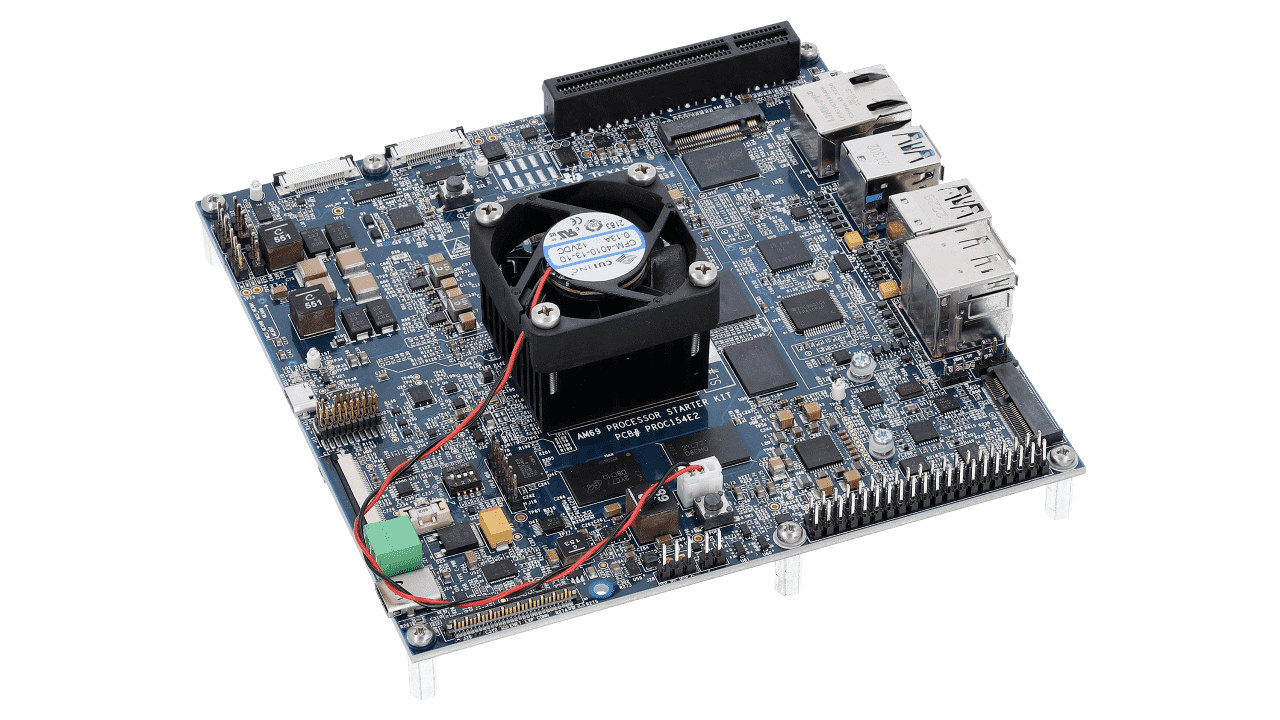MYiR Tech has just announced the tiny, yet full-featured MYC-YM62X CPU module powered by Texas Instruments Sitara AM6231, AM6252, or AM6254 Cortex-A53/M4 processor for HMI and IoT applications as well as the corresponding MYD-YM62X development board used for evaluation. The new MYiR module joins other Texas Instruments AM62x system-on-modules such as Toradex Verdin AM62, Forlinx FET625x-C, Variscite VAR-SOM-AM62, and others, but at just 45x43mm, it is the smallest AM62x CPU module we’ve seen so far yet the company says it still provides access to all features from the processor thanks to its 222 castellated holes. MYC-YM62X CPU Module Specifications: SoC (one or the other) Texas Instruments AM6254 (AM6254ATCGGAALW) with quad-core Cortex-A53 @ 1.4GHz, Cortex-M4F real-time core @ 400MHz, 3D GPU, 2x PRU-SS running up to 333MHz Texas Instruments AM6252 (AM6252ATCGGAALW) with dual-core Cortex-A53 @ 1.4GHz, Cortex-M4F real-time core @ 400MHz , no GPU, PRU-SS running up to 333MHz Texas Instruments […]
Linux 6.4 release – Main changes, Arm, RISC-V and MIPS architectures
Linux 6.4 has just been released by Linus Torvalds on the Linux Kernel Mailing List (LKML): Hmm. Final week of 6.4 is done, and we’ve mainly got some netfilter fixes, some mm reverts, and a few tracing updates. There’s random small changes elsewhere: the usual architecture noise, a number of selftest updates, some filesystem fixes (btrfs, ksmb), etc. Most of the stuff in my mailbox the last week has been about upcoming things for 6.5, and I already have 15 pull requests pending. I appreciate all you proactive people. But that’s for tomorrow. Today we’re all busy build-testing the newest kernel release, and checking that it’s all good. Right? Released around two months ago, Linux 6.3 brought us AMD’s “automatic IBRS” Spectre defense mechanism, additional progress on the Rust front with User-mode Linux support (on x86-64 systems only), the NFS filesystem (both the client and server sides) gained support for […]
Snagboot is an open-source cross-vendor recovery tool for embedded targets
Bootlin has just released the Snagboot open-source recovery tool for embedded platforms designed to work with multiple vendors, and currently STMicro STM32MP1, Microchip SAMA5, NXP i.MX6/7/8, Texas Instruments AM335x and AM62x, and Allwinner “sunxi” processors are supported. Silicon vendors usually provide firmware flashing tools, some closed-source binaries, that only work with their hardware. So if you work on STM32MP1 you’d use STM32CubeProgrammer, while SAM-BA is the tool for Microchip processors, NXP i.MX SoC relies on UUU, and if you’ve ever worked on Allwinner processors you’re probably family with sunxi-fel. Bootlin aims to replace all those with the Snagboot recovery tool. The Python tool is comprised of two parts: snagrecover using vendor-specific ROM code mechanisms to initialize external RAM and run the bootloader (typically U-Boot) without modifying any non-volatile memories. snagflash communicates with the bootloader over USB to flash system images to non-volatile memories, using either DFU, USB Mass Storage, or […]
iW-RainboW-G55M is an OSM-LF compliant module based on TI AM62A Cortex-A53 processor
iWave Systems iW-RainboW-G55M is an OSM Size L compliant system-on-module based on Texas Instruments AM62A single to quad-core Cortex-A53 processor with up to 8GB RAM, 128GB eMMC flash, and a wireless module with WiFi 6, Bluetooth 5.2, and 802.15.4 radios. The iW-RainboW-G55M can leverage the vision processing and deep learning accelerator and the Arm Cortex-R5F real-time cores for control and device management found in the AM62A processor, as well as its display and camera interfaces, peripheral and networking options, to develop products for “man-machine applications at the edge”. iW-RainboW-G55M SoM specifications: SoC – Texas Instruments AM62A SoC (AM62A3, AM62A3-Q1, AM62A7, or AM62A7-Q1) Application processor – Up to four Arm Cortex- A53 cores @ 1.4GHz Real-time cores 1x Cortex-R5F @ 800MHz (MPU Channel with FFI) 1x Cortex-R5F @ 800MHz to support Device Management C7xV-256 Deep Learning Accelerator up to 2 TOPS System Memory – 2GB (default) to 8GB LPDDR4 RAM Storage […]
Linux 6.3 release – Notable changes, Arm, RISC-V and MIPS architectures
Linux Torvalds has just announced the release of Linux 6.3 on the Linux Kernel Mailing List (LKML): It’s been a calm release this time around, and the last week was really no different. So here we are, right on schedule, with the 6.3 release out and ready for your enjoyment. That doesn’t mean that something nasty couldn’t have been lurking all these weeks, of course, but let’s just take things at face value and hope it all means that everything is fine, and it really was a nice controlled release cycle. It happens. This also obviously means the merge window for 6.4 will open tomorrow. I already have two dozen pull requests waiting for me to start doing my pulls, and I appreciate it. I expect I’ll have even more when I wake up tomorrow. But in the meantime, let’s enjoy (and test) the 6.3 release. As always, the shortlog […]
conga-STDA4 SMARC 2.1 module features TI TDA4VM/DRA829J Jacinto 7 processor
congatec conga-STDA4 is a SMARC Computer-on-Module (CoM) based on Texas Instruments TDA4VM or DRA829J Jacinto 7 processor with two Cortex-A72 cores, six real-time Cortex-R5 cores for functional safety, accelerated vision and AI processing capabilities, and plenty of interfaces. The first Texas Instruments-powered CoM from the company is designed for industrial mobile machinery requiring near-field analytics, such as automated guided vehicles and autonomous mobile robots, construction and agricultural machinery, as well as any industrial or medical solutions requiring energy-efficient computer vision at the edge. conga-STDA4 specifications: SoC – Texas Instruments Jacinto 7 TDA4VM/DRA829J with Dual-core Arm Cortex-A72 up to 2.0 GHz 6x Arm Cortex-R5F cores @ 1.0 GHz up to 8 MB of on-chip L3 RAM 1x C7x DSP up to 80 GFLOPs 2x C66 DSPs up to 40 GFLOPs Up to 8 TOPS MMA AI accelerator PowerVR Rogue 8XE GE8430 3D GPU with support for OpenGL ES 3.1, OpenVX, OpenCL […]
OSD62x SiP combines TI AM62x processor with LPDDR4, EEPROM, PMIC, and passives into a single package
Octavo Systems OSD62x is a system-in-package (SiP) combining the Texas Instruments AM62x processor with LPDDR4 RAM, EEPROM, power management, oscillators, and passive components, plus optional features such as an RTC and an 8-channel ADC. At least that’s true for the OSD62x Max Integration SiP (22×22 mm BGA), but Octavo Systems also have a smaller 14x9mm package called the OSD62x Size Optimized with “just’ the AM62x processor, LPDDR4 memory, and passive components. OSD62x “Max Integration” specifications: SoC – Texas Instruments AM62x (AM623/AM625) CPU – Up to 4x Arm Cortex-A53 @ 1.4GHz MCU – Arm Cortex-M4F GPU – 3D graphics up to 2048×1080 @ 60 fps (AM625 only) Storage I/F – 1x eMMC, 2x SDIO, 1x GPMC Display I/F – 24-bit RGB MIPI DPI and OLDI/LVDS Camera I/F – 1x MIPI CSI-2 with DPHY 1.2 Networking – 2x 10/100/1000M Gigabit Ethernet with TSN support USB – 2x USB 2.0 interfaces PRU-ICSS Other […]
Texas Instruments unveils AM62A, AM68A and AM69A Arm Cortex Vision processors and devkits
Texas Instruments AM62A, AM8, and AM69A Arm Cortex-A53 or Cortex-A72 Vision processors come with 2 to 8 CPU cores and deep learning accelerators delivering from 1 TOPS to 32 TOPS for low-power vision and artificial intelligence (AI) processing in applications such as video doorbells, machine vision, and autonomous mobile robots. Three families and a total of 6 parts are available: AM62A3, AM62A3-Q1, AM62A7, and AM62A7-Q1 single to quad-core Cortex-A53 processors support one to two cameras at less than 2W in applications such as video doorbells and smart retail systems. Equipped with a 1TOPS vision processor, the AM62A3 is the cheapest model of the family going for US$12 in 1,000-unit quantities. AM68A dual-core Cortex-A72 processor can handle one to eight cameras in applications like machine vision, with up to 8 TOPS of AI processing for video analytics. AM69A octa-core Cortex-A72 SoC supports up to 12 cameras and achieves up to 32 […]


